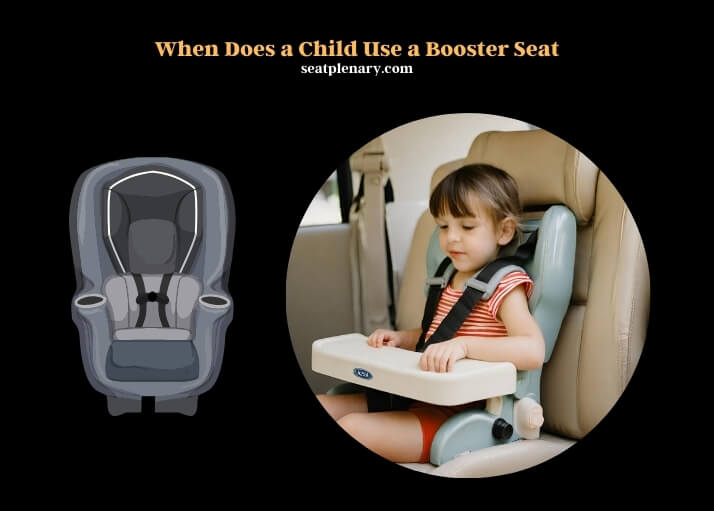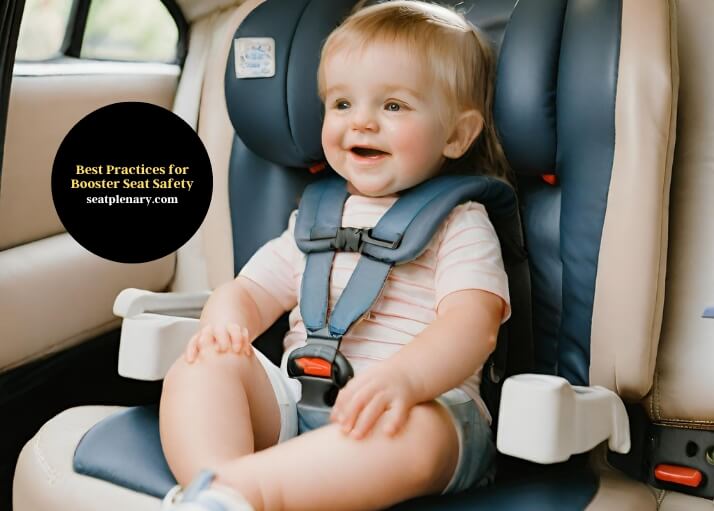A child typically transitions to a booster seat once they outgrow the maximum height or weight limit for their forward-facing car seat. This change usually occurs between the ages of 4 and 7 years.
The shift to a booster seat is a pivotal moment in a child’s development, signifying a step towards greater independence. It’s essential for the booster seat to be used correctly to ensure the child’s safety. The seat raises the child so that the car’s seat belt fits over their body correctly, providing optimal protection.
The lap belt should lie flat across the upper thighs, not the stomach, while the shoulder belt should cross the middle of the chest and shoulder. This correct positioning is crucial in reducing the risk of injury in the event of an accident.

Parents should also consider the type of booster seat that best fits their child’s needs and their vehicle. Options include high-back boosters, which offer additional support and are ideal for cars without headrests, and backless boosters, suitable for vehicles with headrests. Regular checks and maintenance of the booster seat are necessary to ensure its continued effectiveness.
Parents must be aware of and adhere to the legal requirements for booster seats in their region, as these can vary.
Transitioning to a Booster Seat: Key Criteria
Transitioning a child to a booster seat is a significant step in their growth journey. This transition is not solely based on age; it involves a combination of factors including the child’s weight, height, and developmental milestones. Different regions have varying legal requirements, making it essential for parents to be aware of their local laws.
Safety standards also play a crucial role in this decision. A child typically moves to a booster seat when they have outgrown the height or weight limit for their forward-facing car seat. The table below outlines the general guidelines for transitioning to a booster seat:
| Age Range | Weight Range | Height Range |
| 4-7 years | Over 40 lbs | Over 35 in |
Booster Seat Varieties and Features
Booster seats come in two main types: backless and high-back. The choice between these depends on the specific needs of the child and the vehicle. Backless boosters are more portable and easier to switch between cars, while high-back boosters provide additional head and neck support.
Compatibility with different vehicle types is a key consideration, as not all booster seats fit in every car model. Installation ease is another crucial factor, ensuring that the booster seat can be securely and correctly fitted. Comfort and design also play a part in the selection process, as a comfortable child is more likely to remain seated properly. The following table compares the features of backless and high-back booster seats:
| Feature | Backless Booster | High-Back Booster |
| Head & Neck Support | Limited | Enhanced |
| Portability | High | Moderate |
Best Practices for Booster Seat Safety
Ensuring the safety of a child in a booster seat involves more than just selecting the right seat. Proper seat belt positioning is crucial; the lap belt must lie snugly across the upper thighs, not the stomach, and the shoulder belt should cross the middle of the chest and shoulder. The placement of the seat in the vehicle also matters.
The safest spot is typically the middle of the back seat. Regular maintenance checks of the booster seat are necessary to ensure it remains in good condition and continues to function as intended. Adhering to guidelines from safety authorities and manufacturers is essential for maximizing safety.

Developmental Impact of Booster Seats
The transition to a booster seat can have several effects on a child’s development. Physically, it supports their growth by providing a more suitable seating option as they outgrow traditional car seats. Psychologically, moving to a booster seat can foster a sense of independence and maturity in a child. It’s also an opportunity to teach them about the importance of vehicle safety.
Ergonomically designed booster seats can aid in proper posture and comfort during car rides. This transition is a key milestone in a child’s journey towards becoming a more independent individual.
Comparative Analysis of Booster Seat Brands
Choosing the right booster seat brand is vital for parents. This decision is often influenced by factors such as consumer reviews, safety ratings, and price. Durability and longevity are also important considerations, as a good quality booster seat should last through a child’s need for it.
Additional features like cup holders, adjustable armrests, and ease of cleaning can sway purchasing decisions. The table below provides a comparison of popular booster seat brands based on consumer ratings and safety:
| Brand | Consumer Rating | Safety Rating |
| Graco | 4.5/5 | 5/5 |
| Diono | 4.0/5 | 4.5/5 |
FAQs
Is My Child Ready for a Booster Seat?
Determining the right time to switch to a booster seat involves more than just age or size. It’s essential to assess if your child can sit properly throughout the journey. This means they should be able to keep their back flat against the seat, not slouch, and keep their feet on the floor.
If your child squirms, slouches, or tries to unbuckle the seat belt, they might not be ready for this transition. It’s not just about physical growth; maturity plays a significant role in ensuring they can use the booster seat safely.
Booster Seat Installation: What Should I Know?
Installing a booster seat correctly is crucial for its effectiveness. First, always refer to the manufacturer’s instructions. The booster seat should be placed on your vehicle’s back seat. Ensure it’s fitted snugly; there should be no movement of more than an inch side-to-side or front-to-back.
If using a high-back booster, adjust the headrest to fit your child’s height. For a backless booster, the vehicle’s seat and headrest must provide adequate back and head support. Regular checks are necessary to ensure the seat remains well-positioned and secure.
Can a Booster Seat be Used on Airplanes?
Booster seats are not typically used on airplanes, primarily because they require a shoulder belt for proper positioning, which most airplane seats do not have. For air travel, it’s recommended to use an FAA-approved child restraint system or a harness for older children.
This ensures your child’s safety during takeoff, landing, and any turbulence. Always check with the airline for their specific regulations regarding child safety seats and any additional guidelines they might have.
How Long Should My Child Stay in a Booster Seat?
The duration a child needs to stay in a booster seat varies, depending on their growth and the specific laws in your area. Generally, children should use a booster seat until they are tall enough to fit properly in a seat belt. This typically happens when they are between 8 and 12 years old and about 4 feet 9 inches tall.
It’s crucial to follow your region’s specific legal requirements and recommendations from child safety organizations.
Can I Use a Second-Hand Booster Seat?
While a second-hand booster seat can be a cost-effective option, there are several factors to consider. First, check the expiration date; booster seats have a limited lifespan. Inspect it for any signs of wear, damage, or previous accidents, which could compromise its safety. Ensure it comes with the original instructions and hasn’t been recalled. If possible, know the seat’s full history before using it. Safety should always be the priority over cost-saving.
Booster Seat vs. Seat Belt: What’s the Difference in Safety?
The primary difference between a booster seat and a regular seat belt lies in how they accommodate a child’s smaller frame. Booster seats raise the child so that the seat belt fits correctly over the stronger parts of their body, such as the chest and pelvis, rather than the neck and stomach. This correct positioning significantly reduces the risk of injury in a crash. A seat belt alone might not provide adequate protection for a child, as it’s designed for adult proportions.
Summary
In conclusion, the transition to a booster seat is a multifaceted decision involving safety, comfort, and developmental considerations. Understanding the types of booster seats and their features helps in making an informed choice. Adhering to safety best practices is paramount for the well-being of the child.
Recognizing the developmental impacts of this transition aids in a smoother adjustment for the child. Finally, a comparative analysis of different brands ensures that parents can choose a booster seat that best fits their child’s needs and their own preferences.
